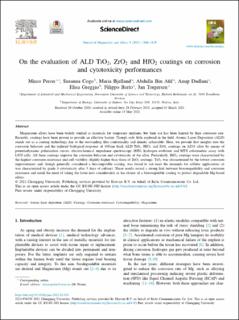| dc.contributor.author | Peron, Mirco | |
| dc.contributor.author | Cogo, Susanna | |
| dc.contributor.author | Maria, Bjelland | |
| dc.contributor.author | Bin Afif, Abdulla Shaikh Abdul Qader | |
| dc.contributor.author | Dadlani, Anup | |
| dc.contributor.author | Greggio, Elisa | |
| dc.contributor.author | Berto, Filippo | |
| dc.contributor.author | Torgersen, Jan | |
| dc.date.accessioned | 2021-10-12T10:41:39Z | |
| dc.date.available | 2021-10-12T10:41:39Z | |
| dc.date.created | 2021-10-01T14:36:13Z | |
| dc.date.issued | 2021 | |
| dc.identifier.citation | Journal of Magnesium and Alloys. 2021, 9 (5), 1806-1819. | en_US |
| dc.identifier.issn | 2213-9567 | |
| dc.identifier.uri | https://hdl.handle.net/11250/2789265 | |
| dc.description.abstract | Magnesium alloys have been widely studied as materials for temporary implants, but their use has been limited by their corrosion rate. Recently, coatings have been proven to provide an effective barrier. Though only little explored in the field, Atomic Layer Deposition (ALD) stands out as a coating technology due to the outstanding film conformality and density achievable. Here, we provide first insights into the corrosion behavior and the induced biological response of 100 nm thick ALD TiO2, HfO2 and ZrO2 coatings on AZ31 alloy by means of potentiodynamic polarization curves, electrochemical impedance spectroscopy (EIS), hydrogen evolution and MTS colorimetric assay with L929 cells. All three coatings improve the corrosion behavior and cytotoxicity of the alloy. Particularly, HfO2 coatings were characterized by the highest corrosion resistance and cell viability, slightly higher than those of ZrO2 coatings. TiO2 was characterized by the lowest corrosion improvements and, though generally considered a biocompatible coating, was found to not meet the demands for cellular applications (it was characterized by grade 3 cytotoxicity after 5 days of culture). These results reveal a strong link between biocompatibility and corrosion resistance and entail the need of taking the latter into consideration in the choice of a biocompatible coating to protect degradable Mg-based alloys. | en_US |
| dc.language.iso | eng | en_US |
| dc.publisher | Elsevier | en_US |
| dc.relation.uri | https://www.sciencedirect.com/science/article/pii/S2213956721000712#! | |
| dc.rights | Attribution-NonCommercial-NoDerivatives 4.0 Internasjonal | * |
| dc.rights.uri | http://creativecommons.org/licenses/by-nc-nd/4.0/deed.no | * |
| dc.title | On the evaluation of ALD TiO2, ZrO2 and HfO2 coatings on corrosion and cytotoxicity performances | en_US |
| dc.type | Peer reviewed | en_US |
| dc.type | Journal article | en_US |
| dc.description.version | publishedVersion | en_US |
| dc.source.pagenumber | 1806-1819 | en_US |
| dc.source.volume | 9 | en_US |
| dc.source.journal | Journal of Magnesium and Alloys | en_US |
| dc.source.issue | 5 | en_US |
| dc.identifier.doi | 10.1016/j.jma.2021.03.010 | |
| dc.identifier.cristin | 1942300 | |
| dc.relation.project | Norges forskningsråd: 245963 | en_US |
| dc.relation.project | Norges forskningsråd: 274459 | en_US |
| cristin.ispublished | true | |
| cristin.fulltext | original | |

